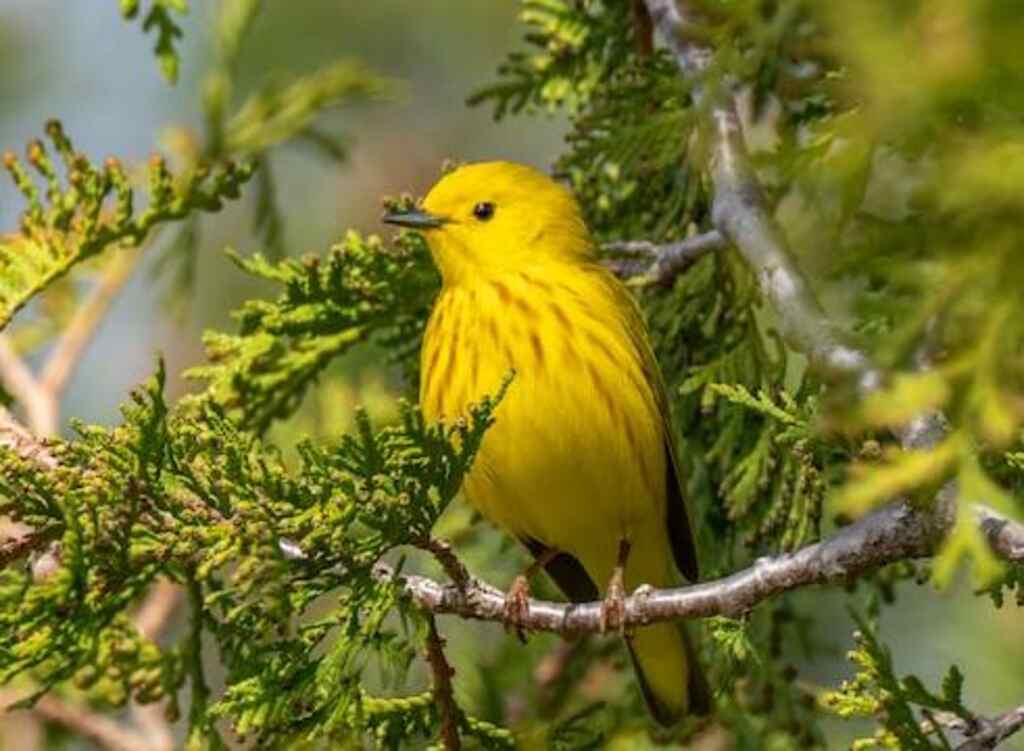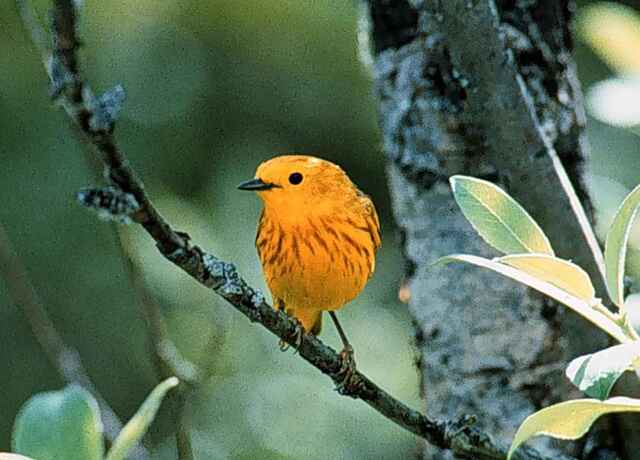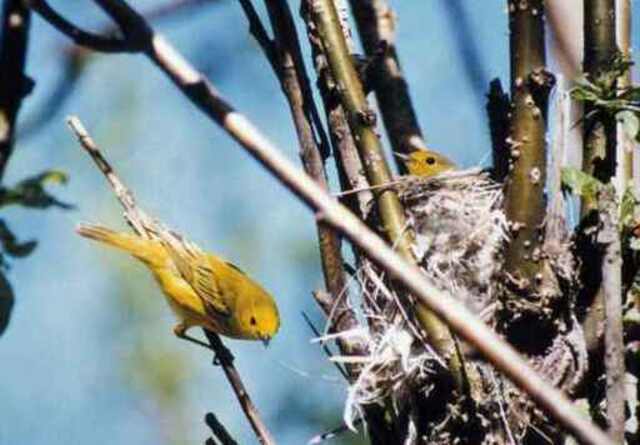
Whether you are a beginner or an expert birdwatcher, there is nothing quite like the thrill of watching yellow warblers flitting around your backyard. From their cheerful twittering to their brilliant yellow and olive plumage, these birds add beauty and life to any garden.
Fortunately, attracting yellow warblers to your backyard is not as difficult as you may think. In this article, we’ll discuss tips for drawing more of these delightful little birds to your yard throughout their migration period. So grab your binoculars, sit back, and get ready to learn how to attract yellow warblers to your backyard fast.
Table of Contents
How to Attract Yellow Warblers to your Backyard
Main Facts
- Length: 4.7-5.1 in (12-13 cm)
- Weight: 0.3-0.4 oz (9-11 g)
- Wingspan: 6.3-7.9 in (16-20 cm)
- Sounds: Calls & Songs (Statistics: eBird)
- Habitats: Backyards, gardens, woods, bushes, swamp edges, streams, thickets along the water edges, lakes, ponds, swamps, marshes, orchards, roadside thickets.
- Maps: Range Map – Sightings Map
- Diet: Insects such as mayflies, moths, mosquitoes, midges, caterpillars, beetles, damselflies, treehoppers, leafhoppers, wasps and spiders. Occasionally they will also feast on berries when available.
- Family: Parulidae
- Genus: Setophaga
- Species: S. petechia
- Bionomial Name: Setophaga petechia (Linnaeus, 1766)
- Scientific Name: Setophaga petechia
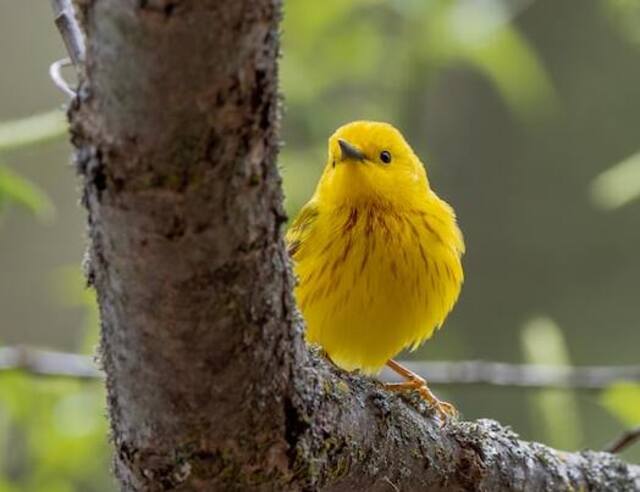
When to Attract the Yellow Warbler?
The American Yellow Warbler (Setophaga petechia) is a small migratory songbird that travels across North America on its journey from wintering habitats in Central and South America to breeding grounds throughout the United States and Canada. The best time to attract this stunning warbler species is from March and early April through the end of August.
During this period, the Yellow Warbler makes long-distance migrations every year. In most areas, individuals arrive as early as late March or April, when they take up residence in marshy wetlands and other lowland areas with shrubs and trees that provide cover and plenty of food resources.
This species loves to eat insects such as caterpillars, beetles, ants and flies which it captures with its short bill. In order to make them easily visible during the spring months, these birds often nest near water or in open meadows, making them easy to spot if you know where to look for them.
By May or June their numbers have increased significantly due to migrating birds that bred over winter coming back north combined with local breeders who will be actively nesting at this time of year.
During the summer months, Yellow Warblers are at peak numbers wherever there are suitable habitat requirements for nesting and raising young birds.
If you visit any nature reserve or wetland area between July and August, you can expect to enjoy seeing lots of these vibrant little birds taking advantage of the abundant insect life.
Finally, by late September the migration season comes around again, with many warblers heading south after having spent much of their summer enjoying sunshine in North America’s warmer climates.
As autumn approaches they become less frequent visitors but can still be seen until October when they disappear entirely until next springtime brings them back once more!
So if you want an opportunity to catch a glimpse of these amazing little creatures, then head out into your nearest wetland area between March/April and late August – excellent times of year to attract yellow warblers!
Plant Trees, Shrubs and Flowers
For those looking to attract the yellow warbler to their garden, understanding when they will come through can be essential. The best time of year for attracting the yellow warbler are the months between April and September.
During this time, these birds will travel from Central America to Canada and back again as part of their yearly migration. They tend to stop in specific areas depending on seasonal weather patterns, as well as searching for ideal nesting sites and food sources along the way.
In order to attract yellow warblers to your yard or garden, it is important to create an inviting environment by planting trees and shrubs that will provide both shelter and sustenance for them. Some of the best varieties for this purpose include:
- Sycamore (for Insects)
- Pine tree (for Insects)
- American Elderberry (for nesting and fruit)
- Eastern Hemlock (for nesting)
- Eastern White Pine (for nesting)
- Maple (for nesting)
- Northern Bayberry
- Oak (for nesting)
- Serviceberry (for fruit)
- Willow (for nesting)
- Hawthorn (for nesting)
- Dogwood (for nesting)
- White Cedar (for nesting)
Planting a variety of these types of berry producing plants will give the birds plenty of options, so they can find what they need while migrating through your area. Yellow warblers love plants that grow berries, some of their favorites are:
- Mulberry
- Blackberry
- Bayberry
- Dogwoods,
- Honeysuckle
- Sumac
- Wild grapes
In order to attract the Yellow Warbler to your garden, you may want to place some nectar producing plants around your home. Try planting some of these plants:
- Trumpet vine
- Trumpet honeysuckle
- Red cardinal flower
- Bee balm
- Columbine
- Lilies
- Pokeweed (for fruit)
- Virginia Creeper (for fruit)
Provide Shelter
Creating a warm and inviting home for American Yellow Warblers in your garden is an excellent way to enjoy their cheerful song and beauty. The best way to attract these birds is during the breeding season, when they are actively seeking suitable nesting sites.
Providing them with shelter requires a combination of thick vegetation and dense foliage. You can achieve this by planting trees such as oaks, maples, and beeches, along with shrubs like willow, hawthorn, and raspberry.
These types of plants create dense cover that warblers prefer for protection from predators and other threats. Adding underbrush or low-growing groundcover provides additional layers of protection for these birds. (for nesting)
Provide Nesting Sites & Materials
Generally, the best times of year to attract Yellow Warblers for nesting is from March to early April. During this time period, they will be searching for potential nesting sites and materials to build their nests with. Yellow Warblers likely build their nests in the forked area of a small tree or bush.
In order to entice them to set up residence near your home, it’s important that you provide nesting materials such as moss, lichen, grass clippings, pine needles and twigs in suitable locations like evergreen or deciduous trees or shrubs.
This provides an ideal habitat for the warblers to breed successfully in and can help draw them closer than usual!
Install a Suet Feeder
One of the most successful methods for attracting these lovely warblers is by using a suet feeder filled with peanut butter or insect suet, as well as a platform feeder with mealworms. I always find these products for the best prices on Amazon. Start by placing the feeders in areas where you have seen the warblers before, such as near bird baths or trees.
Suet will draw them from a distance and provide an energy boost. Mealworms are also an excellent way to entice them up close. Make sure to place the platform feeders at a height that makes it easy for the warblers to access, too low may make them wary of predators; too high may discourage them altogether!
To attract these stunning creatures to your backyard with fruit, why not try offering orange slices and grape jelly? Orange slices are great and will provide them with plenty of nutrients while they’re feasting on it.
Grape jelly contains lots of sugar, which helps attract more species of birds. Place both items in birdfeeders or on nearby trees and enjoy watching the Yellow Warblers come take part in the feast! I have had great success attracting them with this orange and grape jelly feeder.
Be persistent with replenishing both options throughout the season, and you’ll likely have regular visits from these beautiful birds – enjoy!
A very effective bird feeder is the Squirrel Buster Squirrel-proof Suet Bird Feeder. For the best foods to entice them, I would recommend peanut butter suet cakes. Find the lowest prices on these products on Amazon.
Provide Their Favorite Foods
One of the best ways to attract this species to your backyard is by offering them their favorite foods – suet (peanut butter or insect), mealworms, grubs, sunflower chips, nectar, orange slices, grape jelly. This will ensure they have plenty of energy throughout their journey!
For avid birders who want to watch these beautiful birds in action, now is the perfect time to start prepping your feeders and adding these items as snacks for your feathered friends.
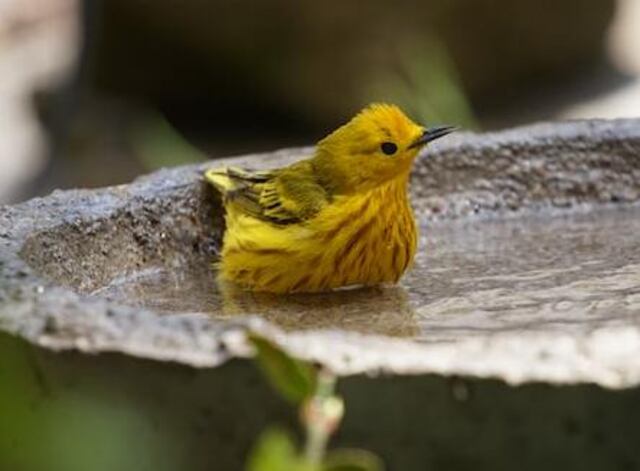
Provide a Birdbath
Attracting American Yellow Warblers to your backyard is simpler than you think! One sure-fire way to attract these birds into your backyard is with a birdbath or even a small running fountain. They are drawn toward the sound of running or dripping water.
To attract them, consider investing in this stylishly designed birdbath, such as this model from Alpine. Amazon has this product at a very reasonable price! During the spring and early summer months, the Yellow Warbler is often seen frequenting birdbaths to drink and cleaning itself.
Providing a great bathing place for these birds throughout spring and summer will improve your odds to receive these amazing visitors into your yard! Position the birdbath in a sheltered area where it is easy for warblers to access and utilize it, and avoid open spaces.
Place it on a solid surface, such as a table or a concrete deck, with the water level no higher than 3 inches deep. Clean the birdbath with clean water regularly, replacing the old water with fresh water each day and removing any debris.
Frequently Asked Questions
Do Warblers feed on the ground?
It is a common misconception that warblers feed on the ground. The research I conducted shows that most of their food intake comes from the insects they find on leaves and berries they find high in trees. However, if given enough time, they will land on the ground to catch insects or eat other small animals.
Do yellow warblers visit feeders?
While these birds don’t typically visit enclosed feeders, you may be able to get them to come to your backyard by setting out an open-style platform feeder or suet feeder. This will provide them with a place to perch while feeding, so make sure you keep it filled with plenty of high quality mealworms or grubs or peanut butter suet! With just a little bit of patience, you may have the opportunity to watch these stunning birds as they flutter around your backyard.
What does it mean to see a yellow warbler?
Seeing a yellow warbler is always cause for celebration. We may not know why, but we can’t help but feel joyous when this small bird lands on our window or tree branch. They are elusive creatures and difficult to find in the wild, so every sighting feels like a gift from Mother Nature herself. Many people associate seeing a yellow warbler with happiness, and many believe that their bright color means good luck!
Are warblers friendly?
The majority of people would agree that warblers are not typically seen as friendly creatures. They are most often described as skittish and timid, with a preference for flying away from human contact, but its been shown that these birds actually enjoy human company and can be socialized to an extent (with proper handling).
Do warblers eat fruit?
When it comes to diet, warblers are mostly insectivores; meaning they primarily feed on insects such as flies, moths, grasshoppers and caterpillars. However, they do occasionally eat fruit too. Fruits like grapes, raisins, apples, bananas or oranges will not only provide them with dietary energy but also increase their overall health condition as well. So if you’re looking to attract Yellow Warblers in your area this spring and summer season, make sure to have plenty of fruits around for them to snack on!
Related Post: How to Attract Warblers to your Yard? (Expert Tips)

